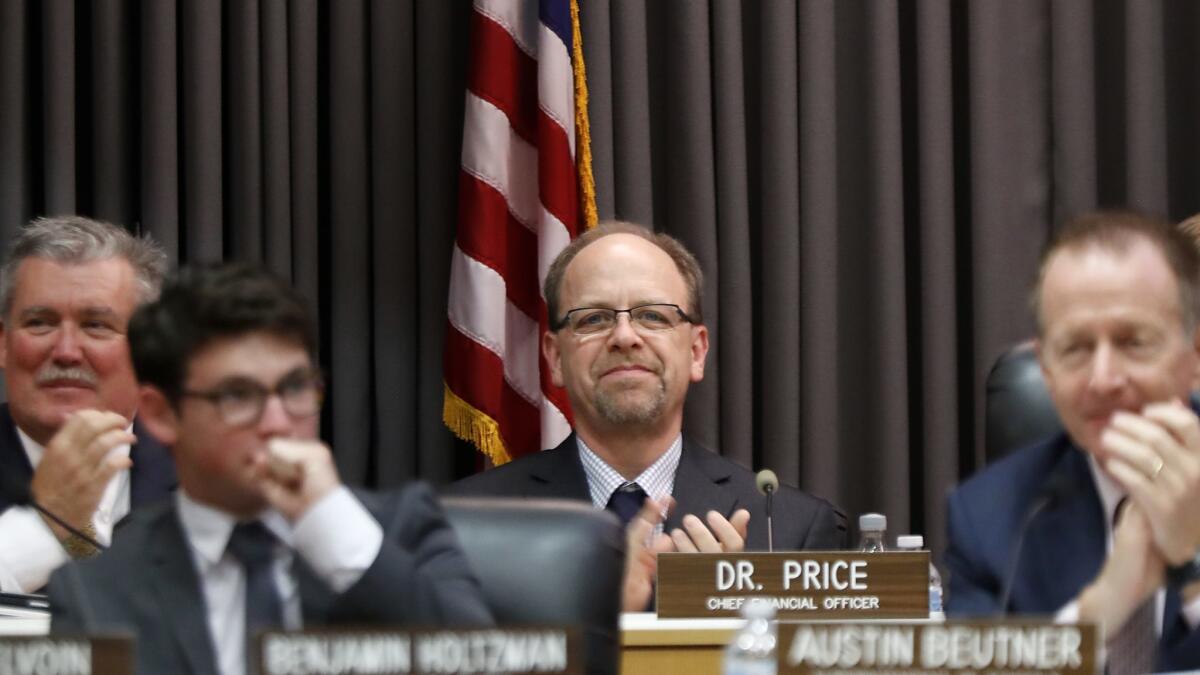L.A. Unified unveils plan to forestall budget crisis a little longer

- Share via
You can add at least one more year to the life expectancy of the Los Angeles Unified School District.
Officials at L.A. Unified had been saying for months that bankruptcy could be three years away. Now district leaders think they can buy more time to come up with a long-term fix.
A tweak here, a slash there and officials are now persuaded they can save $258 million.
Employees, meanwhile, can still expect to get raises.
The Los Angeles Board of Education discussed budget matters Tuesday, a week before it is scheduled to approve a spending plan for next year. There remains broad disagreement on and off the board over the depth of the funding crisis, what to do about it and how best to spend whatever money is available.
The teachers union is pushing for a bigger raise than what the district is offering. Union leaders point to a district cash reserve that may be higher than it’s ever been.
The district’s financial managers argue, however, that a massive structural deficit requires the district to trim spending immediately.
“We’re spending more than we’re bringing in... about a half billion more per year, which is problematic,” Chief Financial Officer Scott Price said in an interview Monday.
This imbalance is caused in part by rising costs for healthcare, pensions and operating expenses. State funding rates, meanwhile, are leveling off while declining enrollment is pushing revenue down.
The budget hawks who believe reducing spending is in order include school board member Nick Melvoin and leaders of an outside advisory task force that until recently included Austin Beutner, the district’s new superintendent.
Beutner has not disclosed his plans to fix budget problems, saying they will be ready in “months, not years.”
Spending cuts could include reining in employee benefits, shrinking payroll through hiring freezes or layoffs and consolidating schools with low enrollment.
The adjusted budget forecast prepared for the board Tuesday was prompted by legal requirements to make public a three-year budget proposal. L.A. Unified officials wanted to show that the district could remain solvent that whole time.
To do so, they needed to find a way to close an estimated $258-million gap for the budget year that begins on July 1, 2020.
They say they can save nearly $86 million by reductions in central office staff — and another $105 million ($35 million for each of the three years) by not having to pay an annual state penalty for having too many administrators. The district contends that the state incorrectly counts its staff — and officials hope for a state waiver of the fee or a legislative fix.
They also say they’ll gain more than $53 million from an expiring lawsuit settlement that has required the district to provide extra services to students at several historically low-performing schools. District staff hope to provide aid to these schools in other ways.
Postponing purchases, they say, will save another $10 million, and a program to improve student attendance will save $6 million more by paying for itself.
If all these plans and projections pan out, the district budget will end up about $78 million in the black for 2020-21, officials say — nearly $3 million above a legally required 1% reserve.
The scenario is optimistic. And some of the proposed savings could negatively affect students and employees. But the moves avoid some of the least popular solutions, such as greatly increasing high-school class sizes and slashing employee benefits.
The proposed budget for next year, in fact, does not trim healthcare benefits, and it sets aside money for raises for all employees. The proposed raises, which still must be negotiated, would be comparable to a three-year agreement approved Tuesday for Local 99, which represents about 30,000 lower-wage, non-teaching workers.
Local 99 members will get a 3% raise (some employees qualify for 4%), and a one-time 3% bonus the next year. That bonus could become permanent, too, if the district can afford it per agreed-upon parameters.
What’s still missing is a long-term cure for the imbalance between revenue and spending. Both the hawks and the unions hope for more funding from the state, increased taxes or both.
An unwillingness to adequately fund schools and compensate district workers represents “a death wish for public education,” said Juan Ramirez, a vice president for the teachers union, United Teachers Los Angeles.
The district, he said, should be aggressively pursuing more revenue instead of talking cuts. Other districts, he said, are pursuing revenue and facilities bonds “and yet we don’t do any of that.”
Melvoin, who was the only board member to vote against the raise for Local 99, said, “It’s not about hard work but about hard choices.… We have been putting off our decisions for too long.”
He faulted the district for continuing to approve spending that could ultimately mean cutting back vital efforts elsewhere — such as music and art programs that benefit students.
More to Read
Sign up for Essential California
The most important California stories and recommendations in your inbox every morning.
You may occasionally receive promotional content from the Los Angeles Times.











